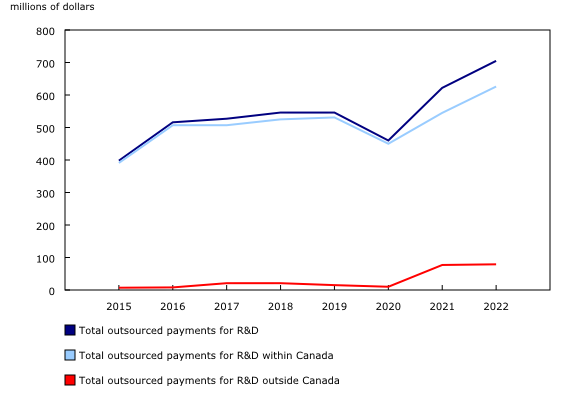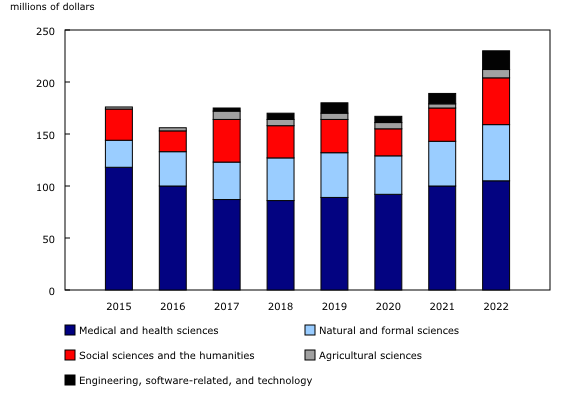Research and development of Canadian private non-profit organizations, 2022
Released: 2024-02-09
Private non-profit organizations in Canada fund and perform research and development (R&D) on issues ranging from studying life-threatening illnesses and protecting endangered species to eradicating poverty and systemic inequalities.
Organizations can either perform R&D themselves, in-house, or outsource it to other organizations, such as universities, hospitals or businesses, either within or outside Canada.
Outsourcing of research and development reaches a new high
While private non-profits can perform their own R&D, they have historically outsourced the majority of the R&D they fund. In 2022, they spent a record $705 million on outsourcing, surpassing the previous high of $622 million in 2021. In total, $626 million, or 88.8%, was directed to organizations within Canada, while the remaining $79 million, or 11.2%, was allocated to outsourced R&D outside Canada. Before 2021, foreign outsourcing had never accounted for more than 4% of all outsourced expenditures.
Organizations increase their in-house research and development spending
In 2022, private non-profits spent $230 million on R&D, a 21.7% increase over 2021. This marks the largest year-over-year percentage increase since 2005. This growth was reflected in both current expenses (+19.6% to $214 million) and capital expenditures (+60.0% to $16 million) and was attributable to new organizations performing or funding R&D, as well as general increases in spending by existing organizations. A corresponding increase was also observed with R&D personnel, as full-time equivalents rose from 1,252 in 2021 to 1,523 in 2022.
Medical and health sciences remain the dominant field of research
Private non-profit organizations spent 45.7% ($105 million) of their in-house spending on medical and health sciences in 2022, up $5 million from 2021. While this marks the largest amount spent in this field since 2015, its share of total spending declined compared with other fields. Spending increased in the natural and formal sciences (+$11 million to $54 million) and social sciences and humanities (+$13 million to $45 million), highlighting the growing diversification of R&D performed by non-profits.
Combined, these three fields made up 88.7% of all in-house R&D spending by private non-profit organizations in 2022, considerably more than the 20.2% for-profit businesses in Canada spent on this grouping in 2021 (the latest year for which data are available). The engineering, software-related and technology fields dominated the business sector, while those fields played a very small role in the private non-profit sector.
Private non-profit sector focuses on applied research
There are three types of in-house R&D: basic research (experimental or theoretical work without any particular application in mind), applied research (investigation directed towards a specific, practical objective) and experimental development (systematic work directed at producing or improving products or processes).
While higher education institutions focus on basic research and the business sector performs mostly experimental development, the private non-profit sector spent 58.7% of its in-house R&D funds on applied research in 2022, compared with 27.0% on basic research and 14.8% on experimental development.
Did you know we have a mobile app?
Get timely access to data right at your fingertips by downloading the StatsCAN app, available for free on the App Store and on Google Play.
Note to readers
Private non-profit organizations provide services to households either without charge or at prices that are not economically significant. For purposes of measuring research and development (R&D) performance, private non-profit organizations include voluntary health organizations, private philanthropic foundations and private research institutes.
The private non-profit sector is residual in nature. Private non-profit organizations that are controlled and financed by government (at least 50%) or affiliated with higher education institutions are excluded from the survey population. R&D expenditures for these excluded private non-profit organizations are included in the R&D expenditures for the government and higher education sectors. Control over private non-profit organizations may change over time, causing volatility within the sector's population.
Contact information
For more information, or to enquire about the concepts, methods or data quality of this release, contact us (toll-free 1-800-263-1136; 514-283-8300; infostats@statcan.gc.ca) or Media Relations (statcan.mediahotline-ligneinfomedias.statcan@statcan.gc.ca).
- Date modified:


